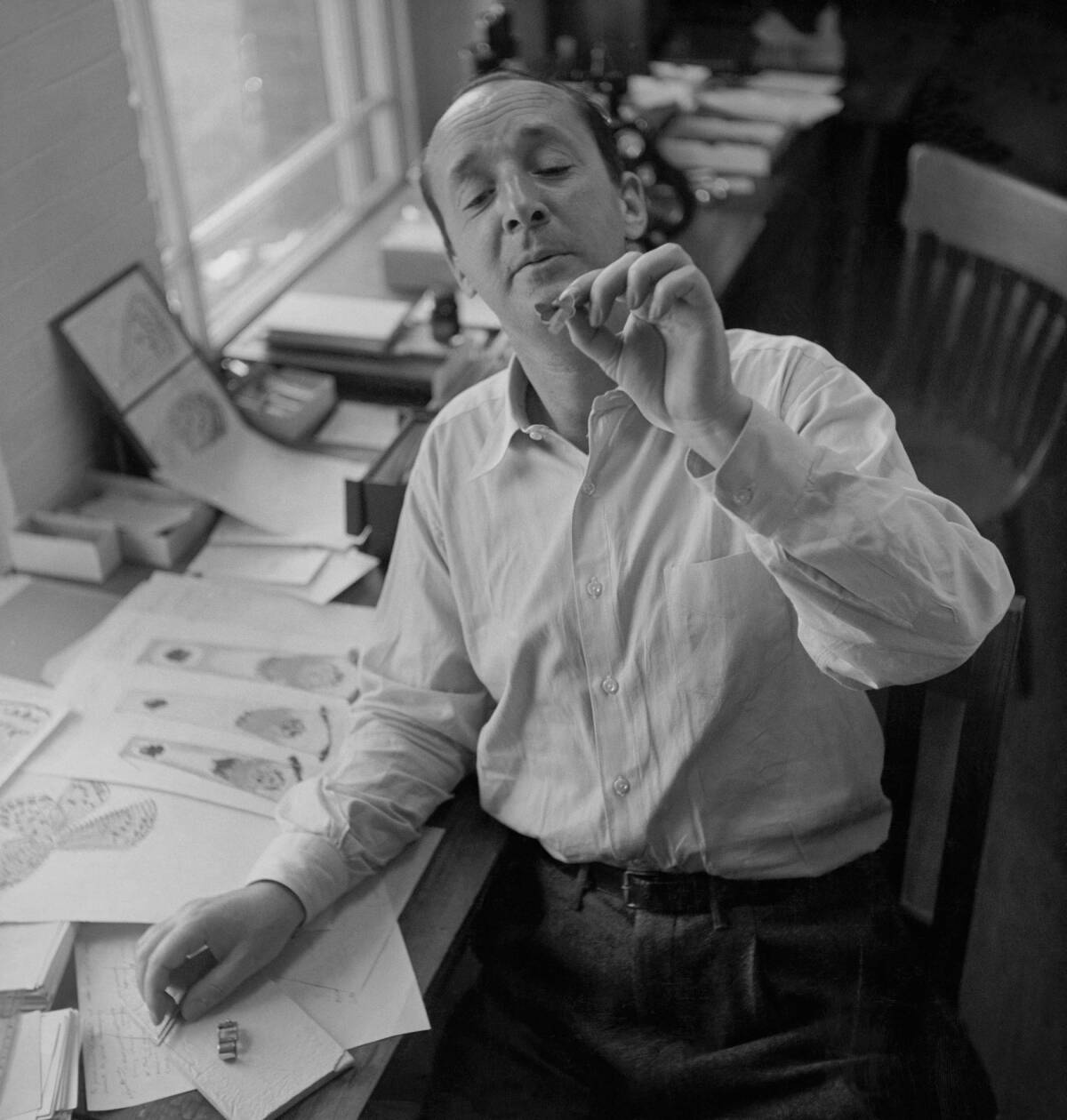The case that partly inspired ‘Lolita’ — despite what Nabokov said
What are the sources of evil? Or literary inspiration? Can these impulses, toward crime and creation, be twins? These are some of the myriad questions evoked by Sarah Weinman’s riveting account of the 1940s true crime that in part inspired Vladimir Nabokov’s “Lolita.”
Often named the greatest English-language novel of the 20th century, upon its publication in 1955, “Lolita” immediately became one of the century’s most notorious. In Britain and France, copies were seized by customs officers and the book was subsequently banned for two years.
Its morally repellent, charismatic narrator, Humbert Humbert, is a pedophile whose obsession with a 12-year-old girl leads him to marry her mother. Upon his wife’s death, Humbert abducts his stepdaughter and embarks upon one of literature’s most infamous road trips. Nabokov, a Russian emigré and amateur lepidopterist, drew on his own annual cross-country journeys with his wife, pursuing rare butterflies between his academic commitments at Wellesley and later Cornell. He composed “Lolita” during these trips.
As Weinman notes, throughout Nabokov’s career, he adhered to “the single-minded Nabokovian belief that art supersedes influence, and so influence must be brushed off.” But a line in “Lolita” pointed to one real-life inspiration: “Had I done to Dolly, perhaps, what Frank Lasalle, a fifty-year-old mechanic, had done to eleven-year-old Sally Horner in 1948?”
Frank La Salle, the kidnapper and pedophile who abducted 11-year-old Sally Horner in 1948, was a serial rapist who preyed on young girls, adopting new identities, pseudonyms and residences with the ease of a habitual con man. The only examples of his writing quoted in Weinman’s scrupulously researched book are appeals documents La Salle composed while serving more than 30 years for Horner’s abduction and rape. In one, he refers to Horner as “Natural Daughter Florence Horner La Salle” and states that “a father cannot be convicted of kidnaping [sic] his own child.” “Remarkable proof of a false narrative,” as Weinman points out.
In other words, fiction — like the novel that brought Nabokov international notoriety and renown. Yet fiction is rarely pure. Few, if any, novelists’ works ever issue solely from the creative imagination, untainted by the familial and romantic entanglements, cultural events and news, fake or otherwise, that can make writers’ inspirations so difficult to pin down, no matter how hard one tries. Nabokov was notably dismissive of such investigative efforts on the part of journalists or readers.
“It is strange, the morbid inclination we have to derive satisfaction from the fact (generally false and always irrelevant) that a work of art is traceable to a ‘true story.’ Is it because we begin to respect ourselves more when we learn that the writer, just like ourselves, was not clever enough to make up a story himself?”

Weinman, a noted editor and writer who specializes in crime stories by often neglected female authors, first wrote about La Salle’s crime and its influence on “Lolita” in a popular 2014 article for the Canadian online magazine Hazlitt.
In her book, Weinman explores the extent to which Nabokov pilfered — in current parlance, appropriated — “a real girl’s plight for his fictional masterpiece.”
“The Real Lolita” incorporates interviews with surviving neighbors and family members of Horner and La Salle, court documents and prison records, newspaper accounts of the crime and archival material relating to Nabokov’s succès de scandale.
What happened
In March 1948, a fifth-grade honor student named Sally Horner attempted to shoplift a five-cent composition notebook from a Woolworth’s in Camden, N.J. She did it on a dare, but before she could abscond with the notebook, she was accosted by a stranger who identified himself as an FBI agent. He was in fact La Salle, who’d already served time for raping five girls under age 15.
“A slender, hawk-faced man loomed above her, iron-grey hair underneath a wide-brimmed fedora, eyes shifting between blue and grey. A scar sliced his cheek by the right side of his nose, while his shirt collar shrouded another mark on his throat. The hand gripping Sally’s arm bore the trace of an even older, half-moon stamp forged by fire.”
After threatening Sally with the reformatory, the man let her go. In June, she encountered him again while walking home from school. Still posing as an FBI agent, he coerced her into going with him to Atlantic City. Presumably terrified that she’d be arrested if she didn’t cooperate, Sally went home and told her mother she’d been invited to go on vacation with a school friend. La Salle telephoned, pretended to be Frank Warner, the father of Sally’s school friend, and persuaded Ella Horner to allow Sally to accompany him and his wife and children on holiday. Despite never having seen or even heard of the Warners, Ella Horner agreed. She wouldn’t see her daughter again for almost two years.
“The Real Lolita” details what is known of Sally Horner’s time with La Salle, along with accounts of the various law enforcement officials involved with La Salle’s pursuit, and, most memorably, the intervention of “a lady friend” in the trailer park where Sally and La Salle were living, which led to the girl’s rescue and her kidnapper’s arrest. These are interwoven with chapters that scrutinize the long, slow-burning fuse that ultimately detonated “Lolita.”
Years before writing that book, Nabokov penned “Volshebnik,” a slender, unpublished novella, under his Russian pen name V. Sirin, posthumously translated by his son, Dmitri, as “The Enchanter” and first published in 1986. As in “Lolita,” a pedophile marries the mother of the child he’s obsessed with, and after the older woman’s convenient death — an illness in “The Enchanter,” a car accident in “Lolita” — he makes his move on her daughter. The main character lacks Humbert Humbert’s seductive, first-person narrative voice that can captivate readers, making them complicit in his crimes. But there are flashes of the sinister beauty that illuminate the darkest moments in “Lolita,” and events (like the death in a car accident of “The Enchanter’s” protagonist) that prefigure central scenes in Nabokov’s masterpiece.
Photos of Horner depict a girl whose sturdy, apple-cheeked good looks are a long way from the elusive beauty Humbert Humbert attributes to young Dolores Haze, one of those children who, “to certain bewitched travelers, twice or many times older than they, reveal their true nature which is not human, but nymphic (that is, demoniac); and these chosen creatures I propose to designate as ‘nymphets.’”
Nabokov creates this name and numerous habitations as Humbert abducts Dolores Haze and takes her on a cross-country journey that mirrors that of Frank La Salle and Sally Horner.
There’s no doubt that Nabokov was familiar with the case, and little doubt that he mined its details for his novel — despite what the author maintained.
In addition to the parenthetical aside in “Lolita,” handwritten notes on an index card Nabokov used for the book — one of the few to survive his regular purges — refer to the death of 15-year-old Horner in a car crash two years after La Salle was captured, just as Dolores Haze dies just a few years after her escape from her stepfather.
As she states in her book, Weinman wasn’t the first to point out the connections between Horner and her fictional counterpart. In 1963, five years after “Lolita’s” American publication, a young writer named Peter Welding published an article in the men’s magazine Nugget. He compared incidents in the novel with those from the real case (gleaned from newspaper reports), and concluded that the two “parallel each other much too closely to be coincidental.”
Alan Levin, a writer for the New York Post, read the Nugget story and wrote to Nabokov, asking about Horner’s kidnapping. Levin subsequently published his own article in the Post, quoting Véra Nabokov’s response to his letter (Véra vetted nearly all her husband’s correspondence). Weinman reproduces the letter in full: Véra Nabokov flatly states, “It [the Horner kidnapping] did not inspire the book.”
Weinman sets out to correct this erasure and honor Sally Horner, the “triple victim: snatched from her ordinary life by Frank La Salle, only for her life to be cut short by car accident, and then strip-mined to produce the bones of ‘Lolita.’”
It’s a noble goal, yet Sally remains the cipher at the book’s center, most alive in the photos that show a smiling child and, even more poignant, the young teenager who never had the chance to grow into a woman. Too many questions remain unanswered and maybe unanswerable. Were she alive today, Sally Horner might have been encouraged to write a memoir of her abuse and escape, or perhaps a novel. She left no diary or letters about the crime; nothing to feed readers’ prurient interest, but also nothing for a true crime writer to utilize.
Weinman has more success underscoring how “Any speculation that ‘Lolita’ could be inspired by a real-life case went against the single-minded Nabokovian belief that art supersedes influence, and so influence must be brushed off.” In researching her book, Weinman is “staggered” by the amount of material relating to “Lolita” in the Nabokov archives — newspaper and magazine clippings, but also girlie mags featuring photos of starlets eager to play Lolita in Stanley Kubrick’s 1962 film adaptation (including an issue of Cosmopolitan with a photo of a then-43-year-old Zsa Zsa Gabor dressed as a 12-year-old). Yet other than that single index card, there is nothing pertaining to Horner.
This seems odd, at the least. Stacy Schiff, Véra Nabokov’s biographer, cautioned Weinman against reading too much into the omission. Weinman counters that “if art was to prevail — and for the Nabokovs, it always did — then explicitly revealing what lay behind the curtain of fiction in the form of a real-life case could shatter the illusion of total creative control.”
“Lolita” ends with Humbert Humbert’s devastating realization, as he listens to children at play, “that the hopelessly poignant thing was not Lolita’s absence from my side, but the absence of her voice from that concord.” Nearly 70 years after Sally Horner’s death, Weinman’s dark and compulsively readable book will make readers aware of the absence of a nearly forgotten girl’s voice in discussions of one of the great works of American literature.
Hand’s book “Curious Toys,” a historical novel featuring Henry Darger, is coming from Mulholland Books next year.
“The Real Lolita: The Kidnapping of Sally Horner and the Novel That Scandalized the World”
Sarah Weinman
Ecco: 320 pp., $27.99
More to Read
Sign up for our Book Club newsletter
Get the latest news, events and more from the Los Angeles Times Book Club, and help us get L.A. reading and talking.
You may occasionally receive promotional content from the Los Angeles Times.






